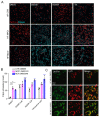Neurodegenerative Lysosomal Storage Disorders: TPC2 Comes to the Rescue!
- PMID: 36139381
- PMCID: PMC9496660
- DOI: 10.3390/cells11182807
Neurodegenerative Lysosomal Storage Disorders: TPC2 Comes to the Rescue!
Abstract
Lysosomal storage diseases (LSDs) resulting from inherited gene mutations constitute a family of disorders that disturb lysosomal degradative function leading to abnormal storage of macromolecular substrates. In most LSDs, central nervous system (CNS) involvement is common and leads to the progressive appearance of neurodegeneration and early death. A growing amount of evidence suggests that ion channels in the endolysosomal system play a crucial role in the pathology of neurodegenerative LSDs. One of the main basic mechanisms through which the endolysosomal ion channels regulate the function of the endolysosomal system is Ca2+ release, which is thought to be essential for intracellular compartment fusion, fission, trafficking and lysosomal exocytosis. The intracellular TRPML (transient receptor potential mucolipin) and TPC (two-pore channel) ion channel families constitute the main essential Ca2+-permeable channels expressed on endolysosomal membranes, and they are considered potential drug targets for the prevention and treatment of LSDs. Although TRPML1 activation has shown rescue effects on LSD phenotypes, its activity is pH dependent, and it is blocked by sphingomyelin accumulation, which is characteristic of some LSDs. In contrast, TPC2 activation is pH-independent and not blocked by sphingomyelin, potentially representing an advantage over TRPML1. Here, we discuss the rescue of cellular phenotypes associated with LSDs such as cholesterol and lactosylceramide (LacCer) accumulation or ultrastructural changes seen by electron microscopy, mediated by the small molecule agonist of TPC2, TPC2-A1-P, which promotes lysosomal exocytosis and autophagy. In summary, new data suggest that TPC2 is a promising target for the treatment of different types of LSDs such as MLIV, NPC1, and Batten disease, both in vitro and in vivo.
Keywords: BK; COPD; TRPA1; TRPM2; TRPML; TRPML3; TRPV2; asthma; cystic fibrosis; emphysema; lung injury.
Conflict of interest statement
The authors declare no conflict of interest. The funders had no role in the design of the study; in the collection, analyses or interpretation of data; in the writing of the manuscript, or in the decision to publish the results.
Figures




References
-
- Rosato A.S., Krogsaeter E.K., Jaslan D., Abrahamian C., Montefusco S., Soldati C., Spix B., Pizzo M.T., Grieco G., Bock J., et al. TPC2 Rescues Lysosomal Storage in Mucolipidosis type IV, Niemann-Pick type C1, and Batten Disease. EMBO Mol. Med. 2022;14:e15377. doi: 10.15252/emmm.202115377. - DOI - PMC - PubMed
-
- Sokol J., Blanchette-Mackie J., Kruth H.S., Dwyer N.K., Amende L.M., Butler J.D., Robinson E., Patel S., Brady R.O., Comly M.E., et al. Type C Niemann-Pick disease. Lysosomal Accumulation and Defective Intracellular Mobilization of Low Density Lipoprotein Cholesterol. J. Biol. Chem. 1988;263:3411–3417. doi: 10.1016/S0021-9258(18)69086-6. - DOI - PubMed
Publication types
MeSH terms
Substances
LinkOut - more resources
Full Text Sources
Research Materials
Miscellaneous

